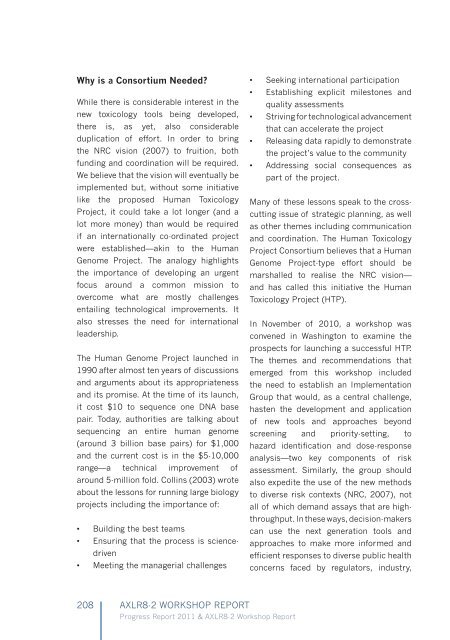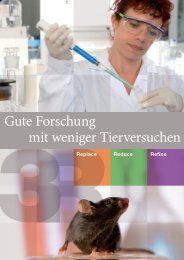You also want an ePaper? Increase the reach of your titles
YUMPU automatically turns print PDFs into web optimized ePapers that Google loves.
Why is a Consortium Needed<br />
While there is considerable interest in the<br />
new toxicology tools being developed,<br />
there is, as yet, also considerable<br />
duplication of effort. In order to bring<br />
the NRC vision (2007) to fruition, both<br />
funding and coordination will be required.<br />
We believe that the vision will eventually be<br />
implemented but, without some initiative<br />
like the proposed Human Toxicology<br />
Project, it could take a lot longer (and a<br />
lot more money) than would be required<br />
if an internationally co-ordinated project<br />
were established—akin to the Human<br />
Genome Project. The analogy highlights<br />
the importance of developing an urgent<br />
focus around a common mission to<br />
overcome what are mostly challenges<br />
entailing technological improvements. It<br />
also stresses the need for international<br />
leadership.<br />
The Human Genome Project launched in<br />
1990 after almost ten years of discussions<br />
and arguments about its appropriateness<br />
and its promise. At the time of its launch,<br />
it cost $10 to sequence one DNA base<br />
pair. Today, authorities are talking about<br />
sequencing an entire human genome<br />
(around 3 billion base pairs) for $1,000<br />
and the current cost is in the $5-10,000<br />
range—a technical improvement of<br />
around 5-million fold. Collins (2003) wrote<br />
about the lessons for running large biology<br />
projects including the importance of:<br />
• Building the best teams<br />
• Ensuring that the process is sciencedriven<br />
• Meeting the managerial challenges<br />
• Seeking international participation<br />
• Establishing explicit milestones and<br />
quality assessments<br />
• Striving for technological advancement<br />
that can accelerate the project<br />
• Releasing data rapidly to demonstrate<br />
the project’s value to the community<br />
• Addressing social consequences as<br />
part of the project.<br />
Many of these lessons speak to the crosscutting<br />
issue of strategic planning, as well<br />
as other themes including communication<br />
and coordination. The Human Toxicology<br />
Project Consortium believes that a Human<br />
Genome Project-type effort should be<br />
marshalled to realise the NRC vision—<br />
and has called this initiative the Human<br />
Toxicology Project (HTP).<br />
In November of 2010, a workshop was<br />
convened in Washington to examine the<br />
prospects for launching a successful HTP.<br />
The themes and recommendations that<br />
emerged from this workshop included<br />
the need to establish an Implementation<br />
Group that would, as a central challenge,<br />
hasten the development and application<br />
of new tools and approaches beyond<br />
screening and priority-setting, to<br />
hazard identification and dose-response<br />
analysis—two key components of risk<br />
assessment. Similarly, the group should<br />
also expedite the use of the new methods<br />
to diverse risk contexts (NRC, 2007), not<br />
all of which demand assays that are highthroughput.<br />
In these ways, decision-makers<br />
can use the next generation tools and<br />
approaches to make more informed and<br />
efficient responses to diverse public health<br />
concerns faced by regulators, industry,<br />
208 AXLR8-2 WORKSHOP REPORT<br />
Progress Report 2011 & AXLR8-2 Workshop Report




